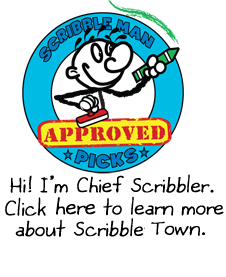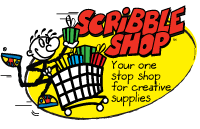Scribble Artist Interview with Timothy Young!
Scribble Town (ST): With us on the Scribble Blog is Timothy Young! Timothy has a long, creative career as an illustrator, graphic designer, toy designer, animator, puppet builder and sculptor and continues to surprise us with his imagination.

Timothy Young with Barney!
Timothy Young (TY): Hi! I live in Maryland with my family on the eastern shore of the Chesapeake Bay. My first book, I’m Looking For A Monster!, came out in 2008 and my 4th book, I Hate Picture Books!, has just come out from Schiffer Publishing.
ST: Where are you and what are you up to these days? I’m sure very excited about your book ‘I Hate Picture Books!’ reaching people everywhere! Please tell us a bit about your book. A little sneak peak please ![]()
TY: I Hate Picture Books! is about a boy named Max who is having a bit of a temper tantrum and is throwing away his picture books. Throughout the book Max describes how picture books have gotten him in trouble and all the while we see him either pictured in these books or showing what he is describing in the style of many classic children’s books that the reader will recognize. I really enjoyed poking fun at many of the books I have loved through the years.

I Hate Picture Books by Timothy Young
ST: Throughout your years of experience have you found a favorite place to write and draw?
TY: I have a home office where I do most of my drawing. I write in many places, including when I’m mowing the lawn or driving in my car. That is, I think up a lot of ideas and write them down later on.
ST: I think writing while mowing the lawn is it’s own art form! What other kinds of art do you practice?
TY: I have done a lot of different types of art. I draw, I sculpt, I use the computer to design graphics and advertising. I use Photoshop to finish most of my illustrations.

A few character designs by Timothy Young
I design toys and I have a new toy line coming out soon called HEDZZ™. I designed them and sculpted the prototypes. I’ll let you know more soon about where to get them. You can see more of my artwork at http://www.creaturesandcharacters.com.
ST: All of your characters whether they are in books or in the shape of a toy have such different personalities. What do you hope to communicate with your stories?

Timothy Young's Books
TY: I don’t start out with any specific message, I usually think of a character and a situation they find themselves in. If some kind of lesson sneaks in there, that’s a plus. Mostly I write books for myself and I hope other people like them too.
ST:What was your favorite storybook growing up? Or is there a character that you connected with especially?

Max Eating Green Ham by Timothy Young
TY: I loved Dr Seuss and P. D. Eastman’s books along with many others. Two of my favorites are no longer in print. I especially liked The Ice-Cream Cone Coot by Arnold Lobel and GWOT! Horribly Funny Hairticklers by Steven Kellogg.
ST: I can see your love for Dr. Seuss in your picture of Max eating green ham (look to your right). Dr. Seuss would have loved that! Your designs and inventions inspire us to go to adventure lands! Where do you get your inspiration from?
TY: Everywhere! I can’t stop these characters and ideas from running around in my brain.
Often times I just doodle things until they become a creature or a character who’s story needs to be told. These days I like drawing on really cheap tracing pads I buy at the supermarket. The paper is rough and I like the line quality I get with my drawing pencils. My favorite pencils are Creatacolor Nero extra soft #1s. Once I have a sketch I like I take another piece of paper and trace over my first to get cleaner lines. Then I scan it into my MacBook Pro and do all of my color work in Photoshop.
I wanted to let everyone know about my contest. If you can name 40 books of the over 250 that are referred to in I Hate Picture Books!, you can enter to win over a dozen autographed books by authors whose books are in my book. You can find all of the details at http://www.ihatepicturebooks.com/contest.html.
ST: Thanks Tim for the challenge! I’m up for it. On your mark, get set, go!

The cover of I Hate Picture Books by Timothy Young




 A Sunday Afternoon on the Island of La Grande Jatte (1884-86) by Georges Seurat
A Sunday Afternoon on the Island of La Grande Jatte (1884-86) by Georges Seurat The Papal Palace, Avignon (1900) by Paul Signac
The Papal Palace, Avignon (1900) by Paul Signac

 Photo:
Photo: 




 Photo:
Photo:  Photo:
Photo: 






 Photo:
Photo:  Photo:
Photo: 





 Photo:
Photo:  Photo:
Photo: 



 Photo:
Photo:  Photo:
Photo: